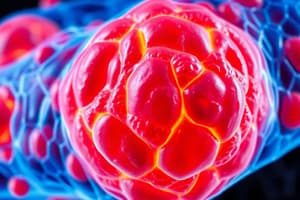Podcast
Questions and Answers
Which type of lesion is characterized by a white patch that cannot be rubbed off?
Which type of lesion is characterized by a white patch that cannot be rubbed off?
- Squamous dysplasia
- Palatal keratosis
- Leukoplakia (correct)
- Erythroplakia
What are the key pathological features associated with leukoplakia?
What are the key pathological features associated with leukoplakia?
- Acne, hyperplasia, and keratoconjunctivitis
- Lichen planus, dysplasia, and eczema
- Solar keratosis, SCC in-situ, and lichen planus
- Hyperkeratosis, parakeratosis, and acanthosis (correct)
Erythroplakia is most commonly found in which locations?
Erythroplakia is most commonly found in which locations?
- Tongue and lip commissures
- Buccal mucosa and gingiva
- Palate and floor of mouth
- Soft palate and tonsillar pillars (correct)
Which of the following is a risk factor specifically associated with leukoplakia?
Which of the following is a risk factor specifically associated with leukoplakia?
Which histological classification is NOT directly associated with smoking?
Which histological classification is NOT directly associated with smoking?
Study Notes
Precancerous Lesions
- Clinical Classification of Lesions:
- Leukoplakia: Most common type, characterized by a white patch/plaque that cannot be rubbed off.
- Erythroplakia: More aggressive than leukoplakia, a reddish plaque/patch with a high risk of malignant transformation, notably on the soft palate and tonsillar pillars.
- Palatal Keratosis with Leukoplakia: A combination lesion indicating potential precancerous changes.
Smoking and Histological Classification
- Histological Features Related to Smoking:
- Squamous Dysplasia: A precursor to cancer marked by abnormal squamous cell growth.
- SCC In-Situ: Squamous cell carcinoma confined to the epithelium, a critical stage before invasive cancer.
- Solar Keratosis: Changes induced by UV exposure, often leading to skin carcinomas.
Leukoplakia (Most Common)
- Characteristics: A non-removable white patch, often associated with smoking, alcohol use, poorly fitting dentures, and jagged teeth.
- Key Pathological Features:
- Hyperkeratosis: Thickening of the outer skin layer.
- Parakeratosis: Retention of nuclei in the surface layer of keratinized cells.
- Acanthosis: Thickening of the stratum spinosum layer of the epidermis.
- Most Common Locations: Notably occurs in buccal mucosa and commissures of lips.
Erythroplakia
- Appearance: Recognized as reddish plaque/patch with a significantly increased risk of malignant transformation.
- Common Locations: Primarily occurs on the soft palate and tonsillar pillars with a risk of malignancy in one of every three cases.
Related Conditions
- Sideropenic Dysphagia: Difficulty swallowing related to iron deficiency.
- Lichen Planus: A common dermatological condition that can affect the oral mucosa.
- OSMP (Oral Submucous Fibrosis): A condition characterized by fibrous bands in the submucosa, leading to restricted opening of the mouth.
- Syphilis: A sexually transmitted infection that can present as oral lesions.
- PLE (Discoid Lupus Erythematosus): An autoimmune condition that can cause skin lesions including in the oral cavity.
- Xeroderma Pigmentosum: A genetic disorder increasing sensitivity to UV light, leading to skin damage and cancer risk.
- Epidermolysis Bullosa (EB): A group of genetic conditions causing fragile skin and mucous membranes that blister easily.
Studying That Suits You
Use AI to generate personalized quizzes and flashcards to suit your learning preferences.
Description
This quiz explores the clinical and histological classifications of precancerous lesions, with a focus on conditions such as leukoplakia and erythroplakia. It highlights key pathological features and risk factors associated with these lesions, particularly in relation to smoking. Test your knowledge on the diagnosis and implications of these crucial precancerous conditions.




